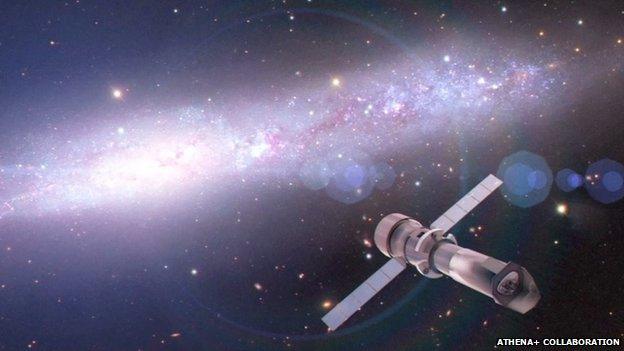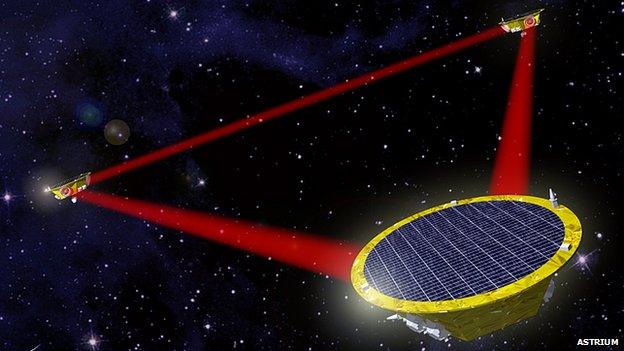European Space Agency sets a path for big space science
- Published
- comments

It is expected that a large X-ray telescope will take the 2028 launch opportunity
Europe has fixed a broad plan for the big space science missions it will launch over the next two decades.
It will likely lead to a large X-ray telescope being launched in 2028, and to an orbiting observatory to detect gravitational waves going up in 2034.
Together, these two ventures will cost in excess of 2bn euros (£1.7bn).
They join a mission already approved known as Juice, which will see a big satellite sent to observe Jupiter and its icy moons in 2022.
The path ahead was set by the Science Programme Committee (SPC) of the European Space Agency (Esa), external, which is meeting in Paris, France.
The committee's decision should now give clear direction and certainty to Europe's research and industrial base.
"These big missions take a long time to put together - of the order of 20 years," said Dr Fabio Favata, head of Esa's Science Planning and Community Coordination Office.
"Of course, when you fix things you trade flexibility for stability, but this gives the community the opportunity to plan. They now understand what will be the 'pillars', what will be the 'cornerstones'," he told BBC News.
The SPC gathering was asked to approve a set of scientific "themes" that will guide the selection of Esa's next Large Class mission opportunities. The agency tries to launch one of these flagship endeavours every six years.
The themes are titled the "hot and energetic Universe", and the "gravitational Universe".
And although these themes do not endorse a specific X-ray telescope or gravitational wave detection concept, their prescription is so tight that only two candidates can have real confidence of making it through the forthcoming selection process.
These are the two consortia that narrowly lost out to the Juice team in the last L-Class competition in 2012.
The X-ray telescope proposal currently goes by the name of Athena+, external. It would be roughly four tonnes in mass and have a 12m focal length. With a survey capability and sensitivity a hundred times better than today's best space telescopes, Athena+ would be used to study the origin of the monstrous black holes that reside at the centres of galaxies, among other objectives.

A Lisa-like observatory would detect gravitational waves using lasers fired across millions of km of space
The gravitational wave observatory goes by the name of Lisa, which stands for Laser Interferometer Space Antenna, external.
It would fire lasers across millions of km of space to try to measure the disturbance in the fabric of space-time, external resulting from exploding stars and merging black holes. It is a concept that has been studied for the better part of 20 years already. Indeed, Esa is about to fly a small satellite called Lisa Pathfinder, external to demonstrate some of the key technologies.
The agency will call for proposals to take the 2028 launch opportunity early next year. There will then be a design phase with various technical reviews before a formal adoption of a mission in about 2018.
"It's very important that Esa takes a long-term perspective," argued Dr Kirpal Nandra, the chairman of the Athena+ collaboration.
"If we don't take such a long-term view then there's a danger universities won't hire people in high-energy astrophysics and black holes and galaxy clusters - because they won't see a future in these areas. But now they can, and they can be pretty much guaranteed that some exciting times lie ahead, especially for the young people just starting out on their careers."
A call for a gravitational wave detection mission will not go out to the community for about five years, and with a launch opportunity no earlier than 2034, it means many of those people who have worked on Lisa will be long retired by the time an observatory of its ilk is taken into orbit.
The advantage is it provides more time to mature the complex technology and to find the international partners needed to fly the most capable architecture possible - something that was compromised back in 2012 when the Americans said they could not afford to participate.
This forced European mission designers to de-scope the proposed laser observatory.
"We've been through a very lean period with the US, but I don't think that will persist indefinitely," says Dr Harry Ward, a Glasgow University scientist in the Lisa collaboration.
"And indeed, at a meeting in Paris recently, the Americans were talking about a contribution being realistic in the timeframes we're now discussing. The amount of money we have on the table is going to make a difference to the architecture we are able to fly."
The L-Class missions of Esa are part of the agency's mandatory programme. That is, all member states contribute to Esa's costs according to the relative size of their economy. This means Germany, the UK, France and Italy contribute the most - in that order. There tend, however, to be additional contributions in the form of instruments, which member states will offer to the projects to secure leadership roles.
The UK has traditionally been very strong in both X-ray astronomy and gravitational wave research, and so scientists in Britain will be looking to the UK Space Agency to play a strong hand when the 2028 and 2034 opportunities come up for adoption.
"The decision this week is about themes, but we know pretty much what sort of missions will deliver those themes," commented Dr Chris Castelli, a UKSA delegate to Esa's Science Policy Committee. "That said, we are some years away from adoption, and we need to take a careful look at the technologies we could fly, and only then work out what everyone's participation should be."
It is interesting to note that the next big science mission to go into orbit will be the billion-euro Gaia star-mapper, due for launch on 19 December. Gaia was proposed as a mission back in 1993, illustrating just what a huge undertaking these types of project have become.

It has taken two decades to get Gaia ready for launch next month
- Published21 August 2013
- Published2 May 2012

- Published3 May 2012
- Published19 April 2012